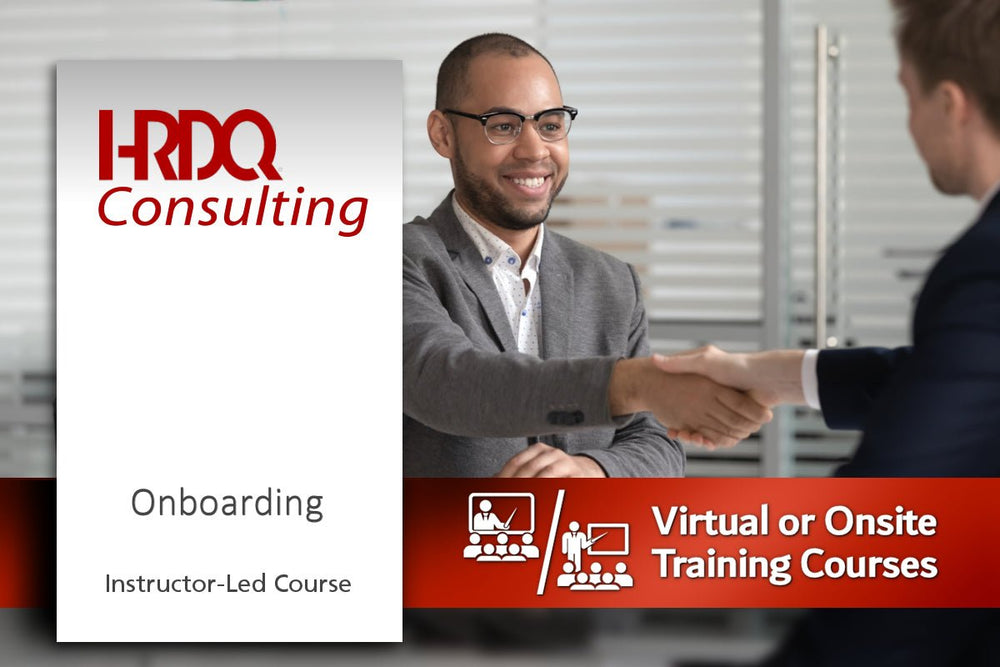Training tools for developing great people skills.
![[Guide] What Are The Different Employee Onboarding Phases? - HRDQ](http://hrdqstore.com/cdn/shop/articles/guide-what-are-the-different-employee-onboarding-phases-549815_1024x500_crop_center.jpg?v=1688797514)
[Guide] What Are The Different Employee Onboarding Phases?
For many organizations, the onboarding process focuses entirely on administrative tasks, such as completing new hire paperwork, ensuring compliance, and explaining policies and processes.
While these steps are essential whenever you hire a new employee, focusing only on these practicalities that serve the needs of the employer can be a big mistake.
Not taking full advantage of the onboarding process can lead to low productivity, high turnover, low engagement, and other adverse outcomes. On the flip side, investing in an onboarding process that supports the employee can improve the employee experience, boost engagement, improve retention, increase productivity, strengthen your company culture, and much more.
Understanding and implementing the five phases of employee onboarding can mean your new employees are happier, more confident, and more comfortable in their roles. The benefits to the organization are enormous and can lead to increased success and growth for the entire company.
Let's get started!

- Establish clear mutual expectations
- Minimize turnover and help hires adjust
- Learn the four onboarding elements
Table of Contents
- The Five Phases of Employee Onboarding
- 1. Pre-Onboarding
- 2. Orientation
- 3. Job-Specific Training
- 4. Initial Performance, Mentoring, and Growth
- 5. Ongoing Development and Nurturing
- Understanding the Benefits of Employee-Focused Onboarding
- 1. Increased Employee Engagement
- 2. Better Employee Experience
- 3. Improved Employee Retention
- 4. Healthier Company Culture
- 5. Improved Talent Acquisition
- 6. Boosted Productivity
- Onboarding the Right Way: An Investment Worth Making!
The Five Phases of Employee Onboarding
You can use our ultimate employee onboarding checklist to ensure your new hires will be up-to-speed on company processes and practices as quickly as possible.
1. Pre-Onboarding
This first phase of employee onboarding commonly begins right after a job offer has been accepted and continues until the new hire's first day.
It's essential to understand just how important this stage of the onboarding process is. In between the time when a candidate accepts a job offer and begins their new role, they are understandably going to experience uncertainty about what is to come and what to expect.

During this time, even the slightest miscommunication or misunderstanding can lead your newest team member to question whether they want to climb aboard your company's ship.
On the other hand, a positive pre-onboarding experience can help increase their motivation to become a part of your organization.
Some of the steps that your company might take during this phase include:
- Helping employees fill out and complete all required paperwork
- Running background checks, drug and alcohol tests, and medical assessments
- Offering assistance in finding housing if the employee is moving from another city or state
- Sharing videos or documents that offer information about the organization and what to expect during the onboarding experience
2. Orientation
When the day finally comes that your new employee is beginning their role with the organization, it's vital to make a strong and positive first impression.
This is an opportunity to ensure that they feel welcome and have access to all information they need to make the transition easier. The new hire might know very little about your company's operations and not know another person working there. For this reason, you'll want to take the opportunity to give them a crystal clear picture of who everyone is, how the organization is structured, and the inner workings of the company.
While giving a warm welcome is good, you also don't want to drag the orientation period on for too long. Employees are often eager to get the ball rolling when starting a new role with a new company. Many companies feel like one week maximum is a good length for an orientation period; however, this can depend on the nature of the company and the role.

During the orientation process, you'll want to:
- Provide a welcoming environment for new hires
- Help new hires understand the culture of the organization
- Provide a clear image of how the company works
- Discuss payroll, attendance, time off, insurance policies and benefits, and other housekeeping
- Direct them to facilities in your building, if applicable
- Provide introductions to the rest of the team
- Hold a meeting at the end of orientation to check-in
To learn more about helping the employee orientation process go more smoothly, check out our guide to putting together a new employee welcome kit.
3. Job-Specific Training
Once you have completed the pre-onboarding and orientation process, it's time to dig into job-specific training. This onboarding phase is essential to your new employees' success at the organization. For them to understand how to thrive in their new role, they will need formal training specific to their job.
When new employees don't clearly understand what is expected of them, they can experience low rates of job satisfaction. That means they might start looking for work elsewhere and increase turnover rates at your organization.

On the other hand, when you have a strong training program in place, it can help them feel at ease in their new role and welcome at the company. The more you invest in their ability to perform at their best, the more new employees will feel that you are prioritizing their development and success.
Some of the steps in this phase can include:
- Familiarizing new hires with your company's learning management system
- Providing a structured onboarding training program that provides information about the mission, vision, policies, and products of the organization
- Giving new employees access to onboarding learning materials in an ongoing manner
4. Initial Performance, Mentoring, and Growth
Once your new hires have received job-specific training, it's time for them to start taking on more responsibility in their role. During this phase, you can institute initial performance reviews to check in with them and give them feedback as they transition into their role.
It's common for the mentoring and growth phase of onboarding to begin about one month after the orientation first starts. This fourth stage will usually last for several months or until the new hire is fully comfortable and confident in their position.

Some organizations choose to match their new hires with mentors during this period. Mentors can meet with new hires in a one-on-one capacity in a regular, scheduled way. Both the sixty-day and ninety-day checkpoints will typically occur during this phase.
5. Ongoing Development and Nurturing
In this final phase of the onboarding process, the focus is primarily on improvement and continuous learning. There will be fewer structured onboarding components at this point (usually past the ninety-day mark), and the new hires will be able to fulfill their roles more independently.

Some organizations will outline clearly defined goals for the continuous learning and improvement of new hires. Whether or not your company chooses to organize this stage at that level, new hires should be fully aware at this point of the performance review process and their performance KPIs. This is essential to ensure they clearly understand their goals and when they're on target to meet them.
Understanding the Benefits of Employee-Focused Onboarding
Let's take a look at some of the most compelling benefits of investing in a five-phase employee onboarding process.

This style of onboarding goes beyond paperwork and ensuring compliance– it focuses on helping employees get up to speed quickly, feel welcomed immediately, and ultimately be set up for long-term success with the organization.
1. Increased Employee Engagement
If your onboarding process is bare-bones and primarily administrative, you'll likely see that new hires aren't nearly as engaged as you might hope.
It's worth investing in helping your employees feel more connected to your company. They need to grasp the organization's mission, vision, and values to totally hop aboard. Similarly, if they don't feel welcomed during the process and simply feel like another name on a spreadsheet at the company, they likely won't be very engaged in their new role.

When your employees are engaged, it can lead to higher productivity and profitability. Beyond that, it can reduce absenteeism as well as turnover. Helping employees become engaged in their new role right off the bat is a worthwhile investment that will pay dividends down the road.
2. Better Employee Experience
Starting a new job is always a bit nerve-wracking, and it's important to remember this when you're welcoming new hires. You and your team already know what makes your company great, but brand-new employees can feel alienated and uncertain if you don't help them see what's so great about your vision, mission, products, and goals.

Though onboarding is essential for administrative paperwork and other necessary tasks, it can do much more for the employee's relationship with their new company. You can think of the onboarding process as the new hire's first impression, which can set the tone for their entire experience with the organization.
For this reason, it's a good idea to focus on things like employee development, frequent check-ins, and company culture. You want them to know that their experience at the organization and on their new team is important to you.
3. Improved Employee Retention
Everyone knows employee turnover is expensive, but they might not realize just how crucial a solid onboarding process is for boosting employee retention.
Of course, there will always be some turnover in any organization. However, the last thing you want is to frequently replace new hires only a few months after investing so much into bringing them aboard.

According to one research brief, companies can increase new hire retention by 82% through a strong onboarding process. This includes beginning with a pre-onboarding phase, as it's common for new hires to have second thoughts and change their mind after they've accepted a job offer.
Generally, getting all the tedious paperwork out of the way right away is advisable. This way, you can focus on things like introductions, welcoming, celebration, and initial learning processes. Allowing new employees to engage in the onboarding process for at least 90 days increases the chances that they will stay long-term in their new roles.
4. Healthier Company Culture
Building and nurturing a healthy, intentional company culture is essential for any modern business. Not only does a strong company culture foster community, teamwork, and inclusivity, but it also has an exponential impact on engagement.

You'll want to take advantage of the opportunity during onboarding to introduce new hires to the company's mission, vision, and values. To really drive home what it means to work for your organization, you can highlight company wins and employee stories.
5. Improved Talent Acquisition
Providing a positive and supportive onboarding experience for new employees doesn't just set these particular workers up for a long, successful career with your company– it can also help you attract new talent down the road.

If an employee is dissatisfied with their new role, they're unlikely to recommend the company they work for to someone they know. They could even go so far as to write negative reviews on online job review sites, potentially damaging your employer brand.
On the other hand, employees with an excellent onboarding experience with your company will rave about the company to their friends, family members, and even on online job review sites like Glassdoor. You can also bring them into your employee referral program so that you can tap into each new hire's network in your ongoing search for talent.
6. Boosted Productivity
Bringing a new employee onto your team is an investment, and it takes time for them to ramp up to their full productive potential. Settling into a new role doesn't happen overnight.

That being said, if you invest in onboarding your new hires correctly, you'll find that they get up to speed much more quickly. When your onboarding process is organized and designed to help new hires build relationships with their team and acclimate to the company, it can mean full productivity and proficiency are reached much more efficiently.
Onboarding the Right Way: An Investment Worth Making!
Investing in employee onboarding will help your team and company thrive. Though building a more robust onboarding experience will require more resources than simply having your new hires fill out paperwork, you'll see that the investment starts paying off right away.
Going through the five phases of onboarding will help ensure that new employees have a great first impression of your company and acclimate to their new role quickly. On top of that, it can increase employee retention, help to strengthen the culture, boost productivity, improve new talent acquisition, and more.
As you build your improved onboarding system, you'll want to gather feedback along the way. Your onboarding process is something that can continue to evolve as your company grows and, in turn, can help you build a strong team of committed and engaged employees that are motivated to stay with your company long-term.

To ensure that your onboarding process is as successful as possible, it's important to understand just how crucial the relationship is between managers and direct reports during the initial period of time a new hire is working with a team.
If you're ready to optimize your onboarding process to help boost retention, job satisfaction, and overall organizational success, check out our Instructor-Led Onboarding Course.
Do you have any questions about the different employee onboarding phases, the benefits of employee-focused onboarding, or anything else we discussed in this article? If so, be sure to leave us a comment down below, and we'll get back to you within a day or two! We make it a point to reply to every comment we receive, and we'd be more than happy to assist you however we can!

- Establish clear mutual expectations
- Minimize turnover and help hires adjust
- Learn the four onboarding elements

About our author
Bradford R. Glaser












![[Guide] Mapping the Path of Erikson's Developmental Process](http://hrdqstore.com/cdn/shop/articles/Eriksons_Developmental_Process.jpg?v=1708737452&width=180)












![[Guide] What Is Vroom's Expectancy Theory of Motivation?](http://hrdqstore.com/cdn/shop/articles/A_Motivated_Employee.jpg?v=1702076987&width=180)




















![[Guide] What Are The Different Employee Onboarding Phases? - HRDQ](http://hrdqstore.com/cdn/shop/articles/guide-what-are-the-different-employee-onboarding-phases-549815.jpg?v=1688797514&width=180)







Leave a comment